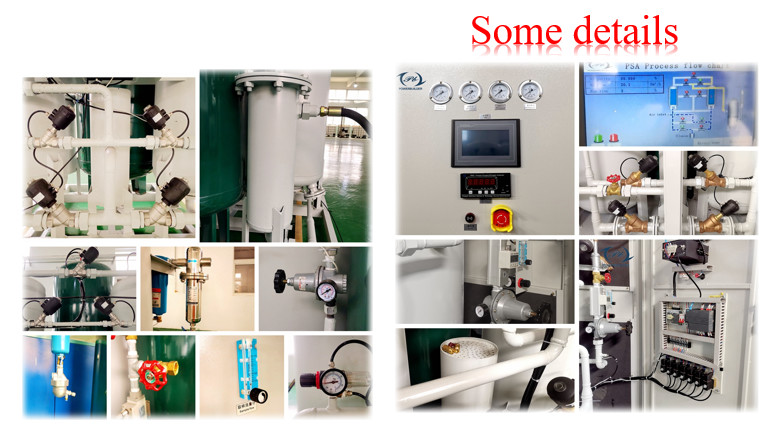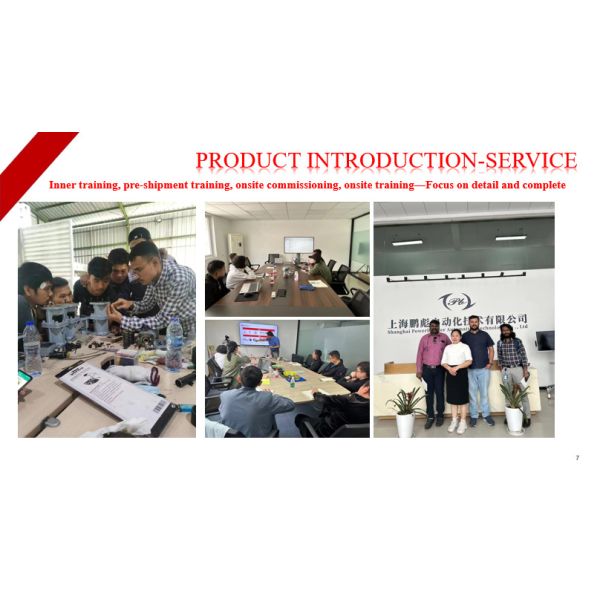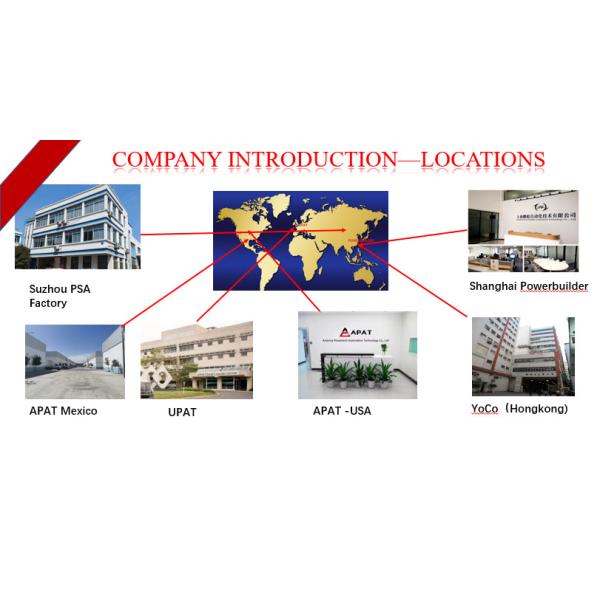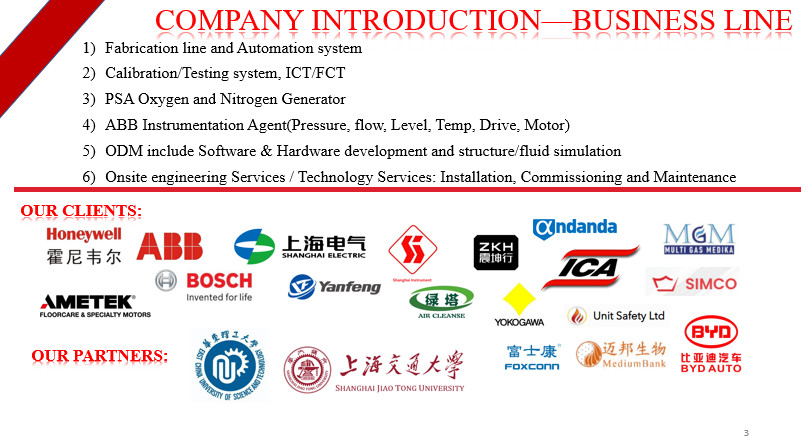Description of 99.9% Purity 100Nm3/H PSA Nitrogen Generator Food, metallurgy, chemical
industry applicable
We have been engaged in the assembly of PSA nitrogen generators and oxygen generators in our factory for 15 years, providing approximately 400 sets of PSA nitrogen generators and oxygen generators for domestic and international customers each year, including production, and debugging.
In collaboration with Burkert Valves, we have customized our own double-acting pneumatic valve. Through the design of top and middle pressure equalization,and airflow orifice plates, we continuously optimize and reduce the air consumption ratio of the equipment, thus achieving energy savings. The energy consumption ratio of our equipment has reached the highest level in China. And through our patented silencer, our device noise is controlled to less than 55 db.
In terms of process flow, we have cutting, welding, assembly, filling of molecular sieves, automatic rust removal, spraying, and complete procedures and supporting equipment for commissioning.
In the supply chain aspect, we provide first-line brands such as Atlas Copco, Ingersoll Rand, GDK, Liutech, Bolaite, Hanbell, and BK for air compressors, and provide Boly, Atlas Copco, and Liutech refrigerated dryers, as well as Anshan Jiapeng and Anqing Bailian boosters.
We can provide supporting equipment and accessories.
Currently, our company's products are aimed at end-users and distributors worldwide. We provide customized remote systems, color customization, display interface customization, and many other OEM services. And we also provide ASME standard equipment and pressure tanks for USA and Australian market.
For specific selection, please contact our customer manager. We hope to become your trusted long-term partner.

| PN3100 PSA Nitrogen Plant Technical Specification |
| lot | Item | Description /Specification |
| 1 | Model/Place of Manufacture | PN3100 |
| 2 | Nitrogen making principle | PSA Pressure swing adsorption PSA变压吸附(开放式结构) |
| 3 | Application | Operation place | Indoor |
| Environment | Ambient temperature | Min -5℃/Max 50℃/ design temperature37℃ |
| Ambient humidity | Min 40%RH Max90%RH |
| 4 | Capacity | 100 | Nm3/hr |
| 5 | Nitrogen Gas Purity | ≥99.9 % Test at outlet of psa Nitrogen |
| 6 | Nitrogen Purity Sensor | HT-TA261 1set |
| 7 | Nitrogen Flowmeter | Japan SMC flowmeter 1 sets |
| 8 | Inlet compress air pressure | 0.75 -0.99Mpa |
| 9 | Inlet Oil Content | ≤0.001mg/m3 |
| 10 | Residual dust | ≤0.01um |
| 11 | Residual water | ≤0.069mg/m3 |
| 12 | Air inlet atmospheric dew point | -15℃ |
| 13 | Demand for clean compressed air | 6.17 | Nm3/min | Recommend Air compressor | 45Kw (6.5m3/min 10Bar )or 37Kw (6.8m3/min 8Bar) |
| 14 | Inlet Diameter | DN40 |
| 15 | Outlet Diameter | DN25 |
| 16 | Maximum inlet temperature | MAX 30 ℃ |
| 17 | Allowable working pressure range | Min7.5Kgf / cm2 Max9.9Kgf / cm2 |
| 18 | Carbon molecular sieve model/origin | CMS-240 |
| 19 | The tower body pipe | 2 sets |
| 20 | Air and nitrogen buffer tank | Piped storage tank |
| 21 | Instrument Tank, silencer | PB Silencer ≤55dB(A) patent number:ZL 2015 2 0545860.3 |
| 22 | Solenoid valve brand/origin | AirTAC | 7 sets |
| 23 | Pneumatic valve brand/origin | PB-Customized | 11 Sets (two for auto drain unqalified Gas) |
| 24 | Control System | Control Power Supply | 0.2kw/set 220V 50 HZ |
| PLC | Mitsubishi core integrated screen /or Siemens S7-200 Smart |
| electrical box | built-in | 1 set |
| touch screen | Mitsubishi core integrated screen/ MCGS |
| 25 | size LxWxH (mm) / Weight:(Kg) | About:1800*1000*2300// 1850kg |
| 26 | Price | 含税含运费 交期20天 | |
2. Working Principles for PSA Nitrogen Generator
Adsorption: Compressed air, consisting of nitrogen and oxygen, enters the PSA nitrogen generator. Inside the generator, the air passes through a bed of adsorbent material, such as carbon molecular sieve (CMS). The CMS has a higher affinity for oxygen molecules, selectively adsorbing them while allowing nitrogen to pass through.
Nitrogen Separation: As the air flows through the CMS bed, the oxygen molecules are trapped and held by the adsorbent material, effectively separating nitrogen from the air stream. This separation process results in the production of nitrogen gas with a higher purity level.
Desorption: Over time, the CMS bed becomes saturated with adsorbed oxygen molecules. To rejuvenate the adsorbent material, the pressure in the system is reduced, triggering the release of the trapped oxygen from the CMS. This desorption step prepares the CMS bed for the subsequent cycle of nitrogen production.
Purge Cycle: To ensure the removal of any residual oxygen and maintain the purity of the nitrogen gas, a portion of the produced nitrogen is directed back into the system. This purge gas displaces any lingering oxygen, effectively purging it from the generator.
Continuous Operation: The PSA nitrogen generator typically comprises multiple adsorption vessels that operate in a cyclic manner. While one vessel is in the adsorption phase, another vessel is undergoing desorption and purge phases. This arrangement ensures a continuous supply of nitrogen gas with the desired purity level.
By harnessing the adsorption and desorption properties of the specialized adsorbent material, the PSA nitrogen generator efficiently separates nitrogen from the air, delivering a consistent and reliable source of high-purity nitrogen gas.
3. Main Features for PSA Nitrogen Generator
- Raw material air is taken from nature. Nitrogen can be produced by supplying compressed air and power.
- Nitrogen purity can be adjusted conveniently and be produced by supplying compressed air
- The equipment is highly automated, produces gas quickly, and can be unattended. Nitrogen can be produced within 10-15 minutes of startup.
- The equipment process is simple, occupies a small area, consumes less energy and costs.
- Molecular sieves are filled by snowstorm method to avoid the pulverization of molecular sieves caused by avoid the pulverization of molecular sieves caused by high-pressure airflow impact and ensure the long-term use of molecular sieves.
- On-line inspection of imported analyzer with high access is simple, occupies a small area, consumes less energy,and costs.
4. Technical indicators
- Capacity Range : 2~2000Nm3/H
- Purity Range : 95%~99.9999%
- Outlet Pressure :0~6Bar or 0~ 8Bar
- Booster outlet pressure range : 10 to 200Bar
- Service Life 8-10 years as long as regular maintenance
Carbon Molecular Sieve
High quality,high density, compact spring loaded, top/bottom balance, protected by a dedicated pressure sensor.
We usually use CMS-240 for purity below 99.99%
And use CMS-260 for purity of 99.999% in one step .
5. Standard Features
- Siemens PLC
- Customized and improved domestic valves
- 7-inch LCD display
- Taiwan AirTAC solenoid valve
- Chengdu Jiuyin Nitrogen analyzer
- SMC flowmeter
- Professional brand molecular sieve
6. Optional Features
- Remote control system
- Better valve of brand Gemu, Burkert
- Dew point analyzer
- Import Molecular Sieve
- Italian ODE solenoid valve
| Item No. | Capacity | Purity | Size mm | Inlet Diameter | Outlet Diameteer | Weight Kg | Power |
| PN3010 | 10Nm3/H | ≥99.9% | 1000*800*1600 | DN15 | DN15 | 300 | AC220V/0.2KW |
| PN3015 | 15Nm3/H | ≥99.9% | 1200*850*1900 | DN15 | DN15 | 400 | AC220V/0.2Kw |
| PN3020 | 20Nm3/H | ≥99.9% | 1200*850*1900 | DN25 | DN15 | 500 | AC220V/0.2Kw |
| PN3025 | 25Nm3/H | ≥99.9% | 1450*900*1900 | DN32 | DN15 | 600 | AC220V/0.2Kw |
| PN3030 | 30Nm3/H | ≥99.9% | 1450*900*1900 | DN32 | DN15 | 700 | AC220V/0.2Kw |
| PN3040 | 40Nm3/H | ≥99.9% | 1450*900*1900 | DN40 | DN15 | 800 | AC220V/0.2Kw |
| PN3050 | 50Nm3/H | ≥99.9% | 1450*900*1900 | DN40 | DN25 | 900 | AC220V/0.2Kw |
| PN3060 | 60Nm3/H | ≥99.9% | 1600*1100*1950 | DN40 | DN25 | 1100 | AC220V/0.2Kw |
| PN3100 | 100Nm3/hr | ≥99.9% | 1800*1000*2300 | DN40 | DN25 | 1850 | AC220V/0.2Kw |
| PN3120 | 120Nm3/hr | ≥99.9% | 1800*1300*2450 | DN40 | DN25 | 2400 | AC220V/0.2Kw |
| PN3150 | 150Nm3/H | ≥99.9% | 2000*1300*2450 | DN40 | DN25 | 2600 | AC220V/0.2Kw |
| PN3200 | 200Nm3/H | ≥99.9% | 2000*1400*2550 | DN40 | DN25 | 2900 | AC220V/0.2KW |
| PN3250 | 250Nm3/H | ≥99.9% | 2200*1500*2650 | DN50 | DN40 | 3400 | AC220V/0.2KW |
| PN3300 | 300Nm3/H | ≥99.9% | 2500*1600*2680 | DN50 | DN40 | 3600 | AC220V/0.2Kw |
| PN3400 | 400Nm3/H | ≥99.9% | 2500*1600*2900 | DN50 | DN40 | 5000 | AC220V/0.2KW |
| PN3500 | 500Nm3/H | ≥99.9% | 2500*1600*3750 | DN80 | DN65 | 7200 | AC220V/0.2KW |
-Applications-
- Application of SMT industry
-
- Semiconductor silicon industry application
Semiconductor and integrated circuit manufacturing process atmosphere protection, cleaning,chemical recovery,etc.
- Electronic components industry application
Selective welding, puring and encapsulation with nitrogen. Scientific nitrogen inert protection has proven to be an essential step in the successful production of high quality electronic components.
- Semiconductor packing industy application
Packaging, reduction, strage with nitrogen.
- Powder metallurgy, metal processing industry
Powder metallurgy is a technique widely used in the metal processing industry. It involves the production of metal parts by compacting and sintering metal powders. The heat treatment industry extensively applies powder metallurgy for various purposes, including annealing and carbonization of steel, iron, copper, and aluminum products.
Additionally, powder metallurgy finds application in high-temperature furnace protection, ensuring the durability and performance of furnace components. It is also utilized in low-temperature assembly processes, where metal parts are joined together at lower temperatures to prevent distortion or damage. Furthermore, powder metallurgy plays a role in plasma cutting, enabling precise and efficient cutting of metal parts.
Overall, powder metallurgy serves as a versatile and valuable technique in the metal processing and heat treatment industries, offering enhanced material properties, improved production efficiency, and a wide range of applications.
- Chemical industry, advanced material industry application
Nitrogen is used to create oxygen - free atmosphere in chemical process, improve the safety of production process, fluid transmission power source, etc: It can be used for nitrogen purging of pipes and vessels in the system, filling nitrogen Storage tank, gas displacement, leak detection, combustible gas protection, chemical reaction agitation, chemical fiber production protection, also used in diesel hydrogenation and catalytic reforming.
Mianly used in food packaging, food preservation, food storage, (Configurable sterilization filter), food drying and sterilization, medicine packing, medical replacement gas, medicine delivery atmosphere, etc.
Ten common questions about nitrogen generators
1.What purity of nitrogen gas can a nitrogen generator produce?
A nitrogen generator can produce nitrogen gas of various purities, ranging from standard industrial-grade nitrogen (typically 95% to 99% purity) to high-purity nitrogen (usually exceeding 99.9%), and even ultra-high purity nitrogen (typically exceeding 99.999%). The choice of purity depends on specific application requirements.
2.What is the working principle of a nitrogen generator?
The working principle of a nitrogen generator is primarily based on either the adsorption technology using molecular sieves or membrane separation technology. Adsorption technology selectively adsorbs oxygen and moisture using a specific adsorbent material, such as molecular sieves, while allowing nitrogen to pass through. Membrane separation technology, on the other hand, utilizes the size and permeability of gas molecules to achieve the separation of nitrogen from other gas components on a membrane.
3.What inputs does a nitrogen generator require, and how does it operate?
A nitrogen generator typically requires air as the input source. When operating the nitrogen generator, air is compressed using an air compressor and then processed through the adsorber with molecular sieves or the membrane separator within the nitrogen generator. Finally, pure nitrogen is obtained as the output. Some nitrogen generators may also require an electrical power supply.
4.How is a nitrogen generator different from nitrogen supply in gas cylinders?
The main difference between a nitrogen generator and nitrogen supply in gas cylinders lies in the mode of nitrogen supply. A nitrogen generator continuously extracts nitrogen from the air, providing a continuous nitrogen supply without the need for cylinder replacements. In contrast, nitrogen supply in gas cylinders requires periodic cylinder replacements, and the supply quantity is limited by the cylinder capacity.
5.What should be considered for the maintenance of a nitrogen generator?
The maintenance of a nitrogen generator typically involves regular cleaning and replacement of the adsorber with molecular sieves or membrane separator, inspection and maintenance of the compressed air system, monitoring nitrogen generation performance, etc. Specific maintenance requirements should be referred to the user manual or guidance provided by the manufacturer of the nitrogen generator.
6.Which industries are nitrogen generators suitable for?
Nitrogen generators are widely used in various industries, including industrial, medical, food and beverage, and laboratory applications. They are commonly used in industries such as chemicals, electronics, and metal processing. In the medical field, they are used for anesthesia and gas delivery. In the food and beverage industry, they are used for packaging and preservation. In laboratories, they are used for atmospheric control and protection of equipment.
7.What is the noise level of a nitrogen generator during operation?
- The noise level of a nitrogen generator can vary based on its specific model and design. In general, nitrogen generators are known for their low noise levels, particularly when compared to traditional compressed air systems. However, for precise information on noise levels, it is recommended to refer to the technical specifications or noise test reports provided by the manufacturer of the nitrogen generator.
- The technical specifications or noise test reports offer detailed information regarding the noise emissions of the nitrogen generator. These documents provide specific noise level measurements, allowing users to assess and compare the noise output of different models. By consulting these specifications or reports, one can gain a better understanding of the expected noise levels and select a nitrogen generator that aligns with their noise requirements.
- The minimal noise levels of nitrogen generators make them highly suitable for a wide range of applications, particularly in environments where noise sensitivity is a concern or industries that prioritize a quiet working environment. This characteristic significantly contributes to creating a more comfortable and productive workspace.
- In noise-sensitive environments such as laboratories, medical facilities, or offices, the low noise emissions of nitrogen generators help maintain a peaceful atmosphere, minimizing distractions and promoting concentration. Additionally, industries that prioritize a quiet working environment, such as research and development, precision manufacturing, or quality control, can benefit from the low noise levels of nitrogen generators to ensure a focused and undisturbed workflow.
- By choosing a nitrogen generator with low noise levels, businesses can create a more conducive and pleasant working environment, leading to increased productivity and employee satisfaction. The consistent and reliable production of nitrogen, coupled with the low noise emissions, allows for uninterrupted operations without compromising on the quality or performance of nitrogen supply.
- Overall, the low noise levels associated with nitrogen generators offer a valuable advantage, allowing for the seamless integration of nitrogen generation into various applications while promoting a tranquil and efficient workspace.
8.How long does it take for a nitrogen generator to start producing nitrogen gas?
The startup time of a nitrogen generator depends on the model and specifications. In general, nitrogen generators have short startup times, typically ranging from a few minutes to several tens of minutes. Larger capacity or higher purity requirement nitrogen generators may require longer startup times.
9.Can a nitrogen generator simultaneously produce nitrogen gas and oxygen gas?
The design purpose of a nitrogen generator is to separate oxygen and nitrogen to produce high-purity nitrogen gas. Therefore, in most cases, a nitrogen generator does not simultaneously produce nitrogen gas and oxygen gas. If simultaneous production of nitrogen and oxygen is required, additional equipment or techniques need to be used for further processing.
10.What is the energy consumption of a nitrogen generator?
The energy consumption of a nitrogen generator varies depending on the model, specifications, and operating conditions. Generally, nitrogen generators have relatively low energy consumption, especially when compared to traditional nitrogen supply in gas cylinders. Nitrogen generators are typically adjusted based on the actual nitrogen demand to improve energy efficiency and minimize energy consumption.
























